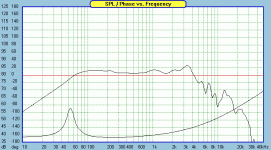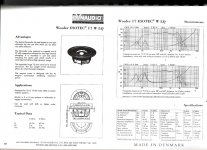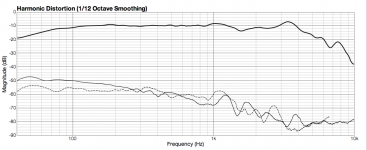I own 4 of the D6G and have done for many years. Do not attempt to use it above 2kHz. It has an almost literal brick wall low pass behavior. Regardless of what they say, the D6G is a woofer only. Midwoofer use does not apply.Hi,
I've been flicking through the spec of these two drivers and to the untrained eye all looks pretty similar, apart from 6.8 is happier crossing over slightly higher at around 2.5kHz as opposed to the G at just under 2kHz - I may be wrong with these figures but I'm just getting used to the idea of driver information.
So the question being if the specs are pretty similar, is there going to be much of a sound repro. difference?
I can only guess the 6.8 may sound a little softer, as the D filled with the glass fibre, a harder material, may sound a little snappier?
Also any other drivers (this size) not going silly expensive that may leave these two for dust?
Many thanks for any thoughts
DC
I own 4 of the D6G and have done for many years. Do not attempt to use it above 2kHz. It has an almost literal brick wall low pass behavior. Regardless of what they say, the D6G is a woofer only. Midwoofer use does not apply.
Not what I would have like to have heard, but very useful info, much appreciate the 1st hand experience,
Cheers!
So far the Forest is still equipped with the D6.8-s, since there is no suitable replacement exists for them. It seems to me that the D6.8 is not in production any more, because the stocks are limited now and prices steadily rising.
Cheers for that, good to know!
From the little I know the D6.8 has 12 mounting holes, like the D6G, but all the Forest Pictures I have seen, and Forest Signature only have 6 screw holes, made me think a new driver was being used...
You are right, that is the Dynaudio Esotec 17W LQ, originally it was an alternative (altough more costly) to the Hi-Vi D6.8, but I guess as eventually the Hi-Vi-s run low on available stock, they were switced to the Dyna-s. While their T-S parameters differ somewhat, the resulting box size comes out almost equal for the two woofers. If you see their response graphs they are almost identical, same applies for their sound, with two exceptions, the Hi-Vi-s produce less distortion at the low end, also their X-max is almost 5 mm (!) more. (the picture on the left is the D6.8 )
Attachments
Cheers dragonweed, Interesting stuff this speaker stuff :-D
Just checked out the:
SB Acoustics SB29RDC-C000-4
Wavecor TW030WA05-01
and they look to me as if they could crossover below 1kHz
where as the
SEAS 25TAF/G
looks like it will just start at 2kHz
So the Seas is just about in with the 6.8, a bit tight with the 6G
and the SB and Wavecor will give plenty of wiggle room with either the 6.8 or 6G
Thanks for the info on the Dynaudio, good to know.
Just checked out the:
SB Acoustics SB29RDC-C000-4
Wavecor TW030WA05-01
and they look to me as if they could crossover below 1kHz
where as the
SEAS 25TAF/G
looks like it will just start at 2kHz
So the Seas is just about in with the 6.8, a bit tight with the 6G
and the SB and Wavecor will give plenty of wiggle room with either the 6.8 or 6G
Thanks for the info on the Dynaudio, good to know.
Just a quick question regarding the HiVi D6.8
Some time ago I asked Ivan Leslie at IPL Acoustics a question about his subwoofer kits but also I asked him about the suitability of the D6.8 ( he sells them ) for a Transmission Line loading. He is a very well respected designer of TL's and he thought they were not suitable but did not inform me why.
Any thoughts on this?
Some time ago I asked Ivan Leslie at IPL Acoustics a question about his subwoofer kits but also I asked him about the suitability of the D6.8 ( he sells them ) for a Transmission Line loading. He is a very well respected designer of TL's and he thought they were not suitable but did not inform me why.
Any thoughts on this?
Any thoughts on this?
Qts is too high. It would cause a bump in the bass response. Actually, a better way to assess suitability is by looking at the efficiency-bandwidth product (EBP).
This is from Wikipedia:
EBP - The efficiency bandwidth product, a rough indicator measure. A common rule of thumb indicates that for EBP>100, a driver is perhaps best used in a vented enclosure, while EBP<50 indicates a sealed enclosure. For 50<EBP<100, either enclosure may be used effectively.
EBP = \frac{F_s}{Q_{es}}
Thiele/Small - Wikipedia, the free encyclopedia
For the purposes of this assessment you can equate transmission line with vented.
Qts is too high. It would cause a bump in the bass response.
Actually, a better way to assess suitability is by looking at
the efficiency-bandwidth product (EBP).
EBP is not a reliable way of knowing which type of box is
to be used. With Qt=0,45 one ought to use larger box volume
than the Vas of the driver for flatter FR. No bump and very good
bass extension. If it's good for reflex, it is for TL too. Simulation
would be a better way.
Put this driver in a closed box without EQ and you will get a
thin sounding speaker.
Regarding post #26, my mistake, dcr of D6.8 is 6,5 ohm.
As I posted earlier the D6.8-s are working perfectly in a Mani 2 sized push-pull compound box, their bottom end is actually better than the M2's. I know it is hopeless to convince anyone by citing personal experiences, but it is really hard to believe what you hear, when you hear them first. So I just try to encourage those who have a few of them around, to build a quick-and -dirty particleboard box (which still wont'be very easy due to its internal structure), too see (hear) what can be expected from a sturdily built version. I am dare enough to put down my two cents on it that your jaws will drop.....
Here are some calculated parameters from the mh.audio.nl.-s online vented box calculator:
Vb: 26.5 liter (which is 13.25liters +compound enclosure volume for P-P)
Fb: 34.1 Hz
Response peak: 0.62 dB at 42Hz
F-3: 30.1 Hz (!)
Also some distortion measurements for the D6.8
Vb: 26.5 liter (which is 13.25liters +compound enclosure volume for P-P)
Fb: 34.1 Hz
Response peak: 0.62 dB at 42Hz
F-3: 30.1 Hz (!)
Also some distortion measurements for the D6.8
Attachments
Shaun and Lokzek,
I have eight of these drivers and four of them will be used for a kind of Mani-2 clone as per Dragonweeds design thoughts. I'd like to try a Transmission line build and thought that these drivers might work, but I am not sure now based on your responses. I do not have the software to model the drivers for TL's so I will have to consider getting it or try an online calculator.
I have eight of these drivers and four of them will be used for a kind of Mani-2 clone as per Dragonweeds design thoughts. I'd like to try a Transmission line build and thought that these drivers might work, but I am not sure now based on your responses. I do not have the software to model the drivers for TL's so I will have to consider getting it or try an online calculator.
Hi Jerryo!
Here is an excellent paper written on TL alignments, I hope it can help... Based on my listening experiences I'd use the 6.8-s in the PPC config, I am not sure you will be able to tune a TL to the same depths as the compound config goes. But the final choice is yours, whichever you choose those are just excellent drivers for both application.
Here is an excellent paper written on TL alignments, I hope it can help... Based on my listening experiences I'd use the 6.8-s in the PPC config, I am not sure you will be able to tune a TL to the same depths as the compound config goes. But the final choice is yours, whichever you choose those are just excellent drivers for both application.
Attachments
jerryo,
try this one:
Transmission Line
thread
http://www.diyaudio.com/forums/software-tools/220421-transmission-line-modelling-software.html
try this one:
Transmission Line
thread
http://www.diyaudio.com/forums/software-tools/220421-transmission-line-modelling-software.html
I have just started to read a little about drivers and still getting to grips with reading the graphs, cabinet design is, well, a whole different area I have not even looked into yet.
But, I am rather tempted, even though I know nothing at the moment, to have a play, or rather, investigate further this push pull configuration (due to low bass responses). I have two pair of old Dittons with two mid/bass drivers in each, they are ported floorstanders, with what I thought was good bass until I heard some D6.8's in some Forest's (even though it is not a tight/snappy as the Ditton's, it goes lower
Some Q's:
I am guessing I need to know more about the my unknown drivers before any ppc cabinet design can take place?
Can you have two pushing and two pulling in the same cabinet?
I guess the tweeter should not be in the same enclosed box as the push pulling drivers?
Should tweeters be treated in the same way as mid/bass drivers when it comes so enclosed or ported cabinet sizing?
I have a feeling, some of the above questions/answers will involve rather a lot of learning if I were to continue on the path of speaker/driver modification/building...
Cheers
DC
But, I am rather tempted, even though I know nothing at the moment, to have a play, or rather, investigate further this push pull configuration (due to low bass responses). I have two pair of old Dittons with two mid/bass drivers in each, they are ported floorstanders, with what I thought was good bass until I heard some D6.8's in some Forest's (even though it is not a tight/snappy as the Ditton's, it goes lower
Some Q's:
I am guessing I need to know more about the my unknown drivers before any ppc cabinet design can take place?
Can you have two pushing and two pulling in the same cabinet?
I guess the tweeter should not be in the same enclosed box as the push pulling drivers?
Should tweeters be treated in the same way as mid/bass drivers when it comes so enclosed or ported cabinet sizing?
I have a feeling, some of the above questions/answers will involve rather a lot of learning if I were to continue on the path of speaker/driver modification/building...
Cheers
DC
Last edited:
I believe that Solen in Canada (Untitled Document) is still selling the 6.8 and has them on sale.
Deaf Cat,
it is always good to know TS parameters of the drivers you
have in mind and best to measure yourself so the results
a simulation gives are realistic.
With push pull configuration you get the same bass extension
(in half as big a box than with a single driver) and decreased non
linear distortion. The price to pay for that is an extra driver and
lowering of impedance in half ( parallel circuit) and the same
SPL/2,83V as for the single driver.
Assuming your driver to start with is 8 ohm nominal, P-P would be
4 ohm and 2 of these would have to be in series to make an 8 ohm
total load unless you have a dynamite amp that drives 2 ohm load
easily.
A series connection of 2 P-P sets would electrically decrease the
SPL/ 2,83 V by 3 dB and accoustically increase by 3 dB. So,
you would end up having the same spl/2,83 V as a single P-P set
with the benefit of speaker becoming an easier load (8 ohm) for
the amp.
Tweeters are usually enclosed by default and therefore need not to be
separated from bass influence inside of the box. Their response shape
near Fs is defined already (Qts) and will be changed with XO filtering.
it is always good to know TS parameters of the drivers you
have in mind and best to measure yourself so the results
a simulation gives are realistic.
With push pull configuration you get the same bass extension
(in half as big a box than with a single driver) and decreased non
linear distortion. The price to pay for that is an extra driver and
lowering of impedance in half ( parallel circuit) and the same
SPL/2,83V as for the single driver.
Assuming your driver to start with is 8 ohm nominal, P-P would be
4 ohm and 2 of these would have to be in series to make an 8 ohm
total load unless you have a dynamite amp that drives 2 ohm load
easily.
A series connection of 2 P-P sets would electrically decrease the
SPL/ 2,83 V by 3 dB and accoustically increase by 3 dB. So,
you would end up having the same spl/2,83 V as a single P-P set
with the benefit of speaker becoming an easier load (8 ohm) for
the amp.
Tweeters are usually enclosed by default and therefore need not to be
separated from bass influence inside of the box. Their response shape
near Fs is defined already (Qts) and will be changed with XO filtering.
Isobaric will not reduce any harmonics. If clamshelled eg min distance between cones will yield control upto roughly 145 Hz give or take 5. Do not allow both drivers to operate above this or extreme cancelations and peaking in the mids will result. If the drivers are butted together at the magnets the upper operating range is lowered.
Above 145Hz the outer driver can operate normally. Best if done actively. Recently have done much testing on iso and concur with Troels. Have a link somewhere, looking...
Above 145Hz the outer driver can operate normally. Best if done actively. Recently have done much testing on iso and concur with Troels. Have a link somewhere, looking...
- Status
- This old topic is closed. If you want to reopen this topic, contact a moderator using the "Report Post" button.
- Home
- Loudspeakers
- Multi-Way
- HiVi D6.8 or D6G, anyone listened to these two drivers?


